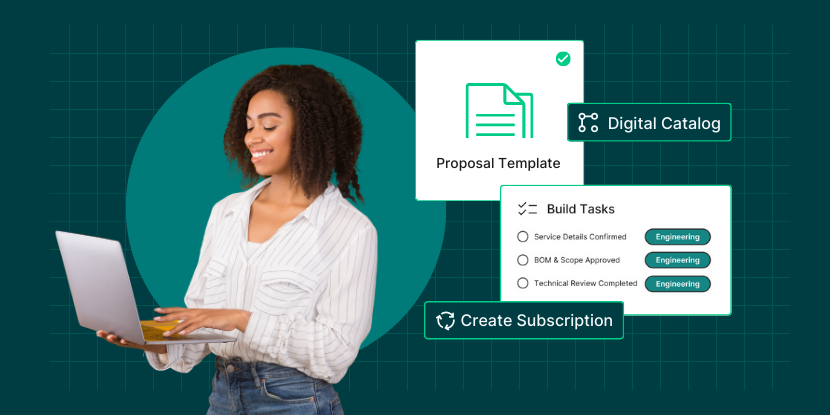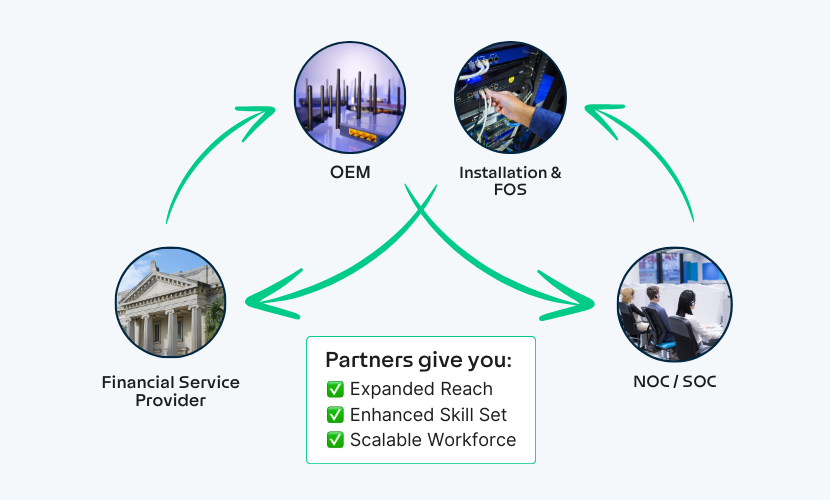
By 2025, businesses and governments will spend over $3 trillion on services alone. Partners are growing faster than vendors, and nearly three-quarters of this business will go through the IT channel.
From what we’ve seen in the IT community, there are two common scenarios:
You’re a VAR looking to start adding services to your business
You’re an MSP or VAR who wants to grow an existing services practice
No matter which category you fall under, how you answer these five questions will determine how much revenue and profit you can expect to earn over the next year through your services business.
Ask yourself:
- Are you quoting services dynamically?
- Are you using standardized statements of work?
- Are you able to offer as-a-Service solutions?
- Are you leveraging partners to make your offerings more scalable?
- Are you providing a modern customer experience?
In this blog, we’ll show you how to create a digitally connected, modern sales process for selling services that builds organic growth.
Sales Hack #1: Connect Your CPQ Process to a Digital Services Catalog
Traditionally, creating a quote for IT services (especially professional services like assessments) is an inefficient process. Endless customization, a lack of standardization, and the dependence on outdated tools creates several issues:

Time to quote: When every quote is customized from scratch, the process becomes complex and labor-intensive, requiring manual work that could be automated. This is why quotes take weeks to produce.
Pricing inconsistencies: Without standardized services, pricing fluctuates based on who’s building the quote. For example, if you were to ask three engineers to build a quote for the same project, you would get three different scopes with three different prices.
Productivity drains: Most MSPs maintain their services information in spreadsheets or a PSA that is not integrated with their other systems. This increases the amount of admin tasks and the probability of making mistakes.
Quoting services that are both accurate, predictable, and quick to quote requires three critical components:
- Digital catalog integrated with your CPQ software
- Service information management system or SIM
- Price automation
The digital catalog and SIM are what you will use to organize and store your standardized service offerings. Each service will include data such as:
- Type of Service: Configuration, installation, monitoring, and other service types.
- Prices and Costs
- Service Descriptions: Standardized descriptions that appear on BOMs, proposals, and SOWs.
- Price Scheduling by Locale: Adjusted pricing based on regional labor costs.
Price automation leverages this data to dynamically adjust the pricing details on your quote, which reduces the time and potential errors in manual pricing.
Together, the digital catalog, SIM, and automated pricing create a process that is dynamic, repeatable, and scalable.
Sales Hack #2: Move your documents to a template-based system
There are several issues that stem from how documents like statements of work (SOW) are built and managed. We’ve analyzed SOW documents from both large and small MSPs, some earning well over 100 million per year in revenue and here are the common problems we found:

- Word is the primary document system
- No standardization: SOWs for similar projects often vary significantly, leading to scope creep risks and misunderstandings for the implementation team.
- There is no template system, creating document management issues
- SOWs are being created from scratch every time
- The customer experience is offline, relying on PDFs and emails.
Over time, MSPs end up with dozens (or even hundreds) of slightly different SOWs that are difficult to track and maintain.
We've seen MSPs juggling 70+ versions of essentially the same document, all to address slight variations in services.
As a result, the entire process becomes too labor-intensive and complicated, causing delays in getting deals closed while also increasing the risk of human error.
A streamlined, template-based document system can solve these issues.
By designing a single, dynamic template tied to your service catalog and integrated into your quote workflow, you can quickly generate SOWs that adapt to each customer’s needs.
Rather than creating a new document each time, you’re simply populating relevant sections of a template.
This approach:
- Standardizes each service
- Reduces time to create SOWs, enabling quick turnaround with prebuilt service descriptions and project phases
- Ensures a consistent customer experience by using structured templates
- Allows easy customization by the sales rep when required
- Minimizes scope creep with clear, predefined milestones and details
- Centralizes SOW management for efficient oversight and consistency across projects
Sales Hack #3: Become a Hybrid Provider (MSP + VAR) with XaaS
Subscriptions and managed services are the foundation of what makes a managed service provider business what it is. You offer a partnership with your customers that provides simplicity and long-term business value.
%20with%20XaaS-1.png?width=830&height=500&name=Become%20a%20Hybrid%20Provider%20(MSP%20%2B%20VAR)%20with%20XaaS-1.png)
If you’re already providing value to your customers through professional and managed services, it’s only natural for them to ask you what else you can do? Can I buy my devices? Can I buy my networking equipment? Etc.
This is why more businesses today are increasingly drawn to as-a-Service models (XaaS) that further increase the value they get from their MSP.
Becoming a hybrid of both a VAR and an MSP by offering XaaS solutions, you can stop leaving revenue on the table, increase your stickiness with the customer and drive massive organic growth.
While this does present the largest growth opportunity for MSPs and VARs alike, there are several challenges that need to be overcome.
This includes questions like:
- How do you build quotes and proposals that combine multiple products and services into a single solution?
- How do you fund each deal that doesn’t come with liability and cashflow risks?
- How do you handle billing and payments?
- How do you provide an all-digital experience for your customers?
The truth is, there aren’t many approaches to this problem that actually provide a realistic path forward MSPs that are affordable and quick to implement.
There are five components that you’ll need to do this correctly:
- Client portal
- Connected tech stack
- Integrated finance
- CPQ software built for as-a-Service
- Support for the entire services lifecycle
You can try to cobble together today’s tools. But in the end, it won’t work the way you want it to and it will cost you an unbelievable amount of time and capital to come to this realization.
This is one of the reasons why we built TechGrid.
TechGrid is the only platform (to our knowledge) that is purpose built to grow an as-a-Service business.
Here’s how TechGrid helps:
- Complete Solution Coverage: Unlike other as-a-Service solutions built by manufacturers and tied to specific products, TechGrid provides solution-specific coverage across various OEMs. For example, with Network as a Service (NaaS), we don’t just include network components like firewalls and switches; we also integrate backup power, racking, and even Internet services to ensure a complete, ready-to-go solution.
- Proprietary Workflow Features: Our workflows include unique tools, such as WiFi coverage calculators and switch quantity estimators, making it easier to deliver the right setup every time.
- Built from Real-World Experience: Our workflows weren’t just imagined by developers; they were crafted from years of operating an MSP, ensuring they’re practical, efficient, and ready for real-world use.
- Fintech Enablement without Liability: Unlike OEM financing that puts financial liability on the MSP, TechGrid finance enablement is backed by leading banks. This means financing is based on customer credit, reducing financial risk for MSPs and making it simpler to offer financing to clients.
With TechGrid, you can:
- Convert any combination of products and services into as-a-Service solutions, giving you the flexibility to offer exactly what your customers need.
- Access funding from leading banks like Wells Fargo
- Build quotes and proposals with automated as-a-Service workflows for faster, more accurate sales.
Sales Hack #4: Leverage the Power of Partnerships
There are several common limitations that impact your ability to grow services revenue:
- Limited Reach and Capabilities: Without trusted partners, MSPs are confined to their own geographic area and limited capacity, restricting the scale and scope of projects they can take on. This self-imposed constraint makes it challenging to grow, as large projects or distant clients remain out of reach.
- Fragmented Collaboration Processes: Even when partnerships are in place, they are often managed offline with manual processes and limited tracking. This disconnected approach introduces inefficiencies, making it difficult to maintain quality and consistency across collaborations.
- Missed Market Opportunities: Partners offer expertise, resources, and market access, but without an efficient way to engage and manage them, MSPs miss out on chances to expand their offerings and win larger deals.

Partners are a largely untapped resource for most MSPs, who often see them as competitors rather than valuable resources.
Most large telcos like AT&T, rely on their partner network for their reach and capability. MSPs need to start thinking of partners as the key to growth and not like competitors.
Aim to facilitate direct connections between service providers and partners to streamline collaboration, control costs, and maintain service quality. By building a structured, integrated partner network within your workflow, you can:
- Expanded Geographic Reach: Partners expand your territory, opening up new regions and markets so you’re no longer confined to your local footprint. More reach means more revenue potential.
- Enhanced Skill Set: With partners on board, you’re not limited to in-house expertise. Add services, win bigger deals, meet diverse client needs, and increase your revenue potential.
- Scalable Workforce: Rather than hiring full-time staff, use partners to scale your team as needed. This supports larger projects and bigger clients without the burden of increased permanent staffing.
Sales Hack #5: Offer your customers a unified client portal
MSPs often fall short when it comes to providing a seamless, digital-first customer experience. Most interactions are still heavily reliant on email, PDFs, and outdated workflows, which creates friction at every stage of the sales and fulfillment process:

- Limited Communication Channels: The traditional MSP model offers little in the way of real-time communication or collaboration. Customers expect responsive, digital-first interactions that email chains and PDFs can’t deliver. Customers are left navigating a fragmented experience, with separate touchpoints for sales, support, and service delivery.
- Lack of Transparency and Accessibility: Without a single point of access for service information, customers are left in the dark about the status of their services and projects, creating frustration and impacting retention.
MSPs need to transition to a modern, digital-first approach that enhances the customer journey from the first contact through ongoing service management.
By implementing a unified client portal where clients can view proposals, track project milestones, and communicate in real-time, MSPs create a seamless experience that aligns with modern expectations.
For ongoing managed services, emphasize proactive support, real-time reporting, and easy communication to foster trust and satisfaction. With this model, customer interactions are streamlined, boosting engagement and building long-term loyalty.
Final Thoughts
The IT services landscape is undergoing a rapid transformation, driven by increasing demand and evolving customer expectations. To thrive in this dynamic environment, MSPs and VARs must embrace digital transformation and adopt innovative strategies.
By addressing the challenges of quoting, SOW creation, as-a-Service delivery, partner collaboration, and customer experience, businesses can unlock significant growth potential. By leveraging technology and streamlining sales and fulfillment processes, MSPs and VARs can:
- Enhance efficiency: Automate manual tasks, reducing time and errors.
- Improve customer satisfaction: Provide seamless, digital-first experiences.
- Increase revenue: Expand service offerings and capture new markets.
- Strengthen partnerships: Collaborate effectively with partners to scale operations.
Leave a comment on LinkedIn to share what you're doing to grow your services business.





